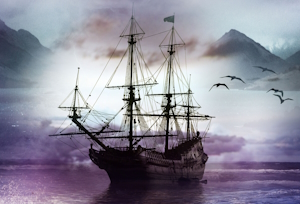 Pirates made use of many types of ships, in particular smaller versatile vessels which could navigate the shallow waters and shoals characteristic of the Caribbean. Bigger was not necessarily better as larger ships with their complex rigging and large area of canvas were more difficult to sail. Although the term ‘ship’ strictly applied to three-masted, fully rigged vessels, the word was often applied to sloops and brigantines at the time. The names applied to seafaring vessels have changed over time, but here the terms here are those used during the Golden Age of Piracy. During this period, ships were often defined by their type of rigging rather than the shape of their hull or number of masts. A lot of ships possessed at least some oars in the early 18th century, whether brigantines, sloops, or frigate-built ships, allowing for more versatility, especially when there was no wind. At the time, the term man-o’-war could be applied to any vessel of any size fitted for war. The term was especially used to designate a pirate flag ship.
Pirates made use of many types of ships, in particular smaller versatile vessels which could navigate the shallow waters and shoals characteristic of the Caribbean. Bigger was not necessarily better as larger ships with their complex rigging and large area of canvas were more difficult to sail. Although the term ‘ship’ strictly applied to three-masted, fully rigged vessels, the word was often applied to sloops and brigantines at the time. The names applied to seafaring vessels have changed over time, but here the terms here are those used during the Golden Age of Piracy. During this period, ships were often defined by their type of rigging rather than the shape of their hull or number of masts. A lot of ships possessed at least some oars in the early 18th century, whether brigantines, sloops, or frigate-built ships, allowing for more versatility, especially when there was no wind. At the time, the term man-o’-war could be applied to any vessel of any size fitted for war. The term was especially used to designate a pirate flag ship.
Common types of ships used by pirates
 Barque – The word barque was used in the late 18th century to refer to a three-masted ship, but in the late 16th and early 17th centuries it was used to describe a much smaller vessel propelled by sails and oars. For the English they were small coastal boats. For the French the term barque-longue referred to a an open low-draft boat with one or two masts. They were about 12 metres long and weighed 10 to 50 tons. They could have up to a dozen oars, but the was no proper deck for mounting cannons. They were primarily used for boarding larger vessels. The double shallop was a barque-longue with a deck and 2 masts, resembling a brigantine. In the late 18th century a barque was a sailing ship with from three to five masts, all of them square-rigged except the after mast, which was fore-and-aft rigged.
Barque – The word barque was used in the late 18th century to refer to a three-masted ship, but in the late 16th and early 17th centuries it was used to describe a much smaller vessel propelled by sails and oars. For the English they were small coastal boats. For the French the term barque-longue referred to a an open low-draft boat with one or two masts. They were about 12 metres long and weighed 10 to 50 tons. They could have up to a dozen oars, but the was no proper deck for mounting cannons. They were primarily used for boarding larger vessels. The double shallop was a barque-longue with a deck and 2 masts, resembling a brigantine. In the late 18th century a barque was a sailing ship with from three to five masts, all of them square-rigged except the after mast, which was fore-and-aft rigged.
Brigantine – The French called this type of vessel a corvette. The term referred more to type of rigging in early 18th century. A brigantine was a two-masted sailing ship, square-rigged with her foremast fully square-rigged and her mainmast rigged with both a fore-and-aft mainsail (a gaff sail) and square topsails, and possibly topgallant sails. It was somewhere between a sloop and a ship. It was fast and with decent firepower, the guns being placed on the open deck. They normally weighed between 15 and 150 tons.

Snow – This was a square-rigged vessel, differing from a brigantine only in that she had a small trysail mast close abaft the mainmast, on which a large trysail is hoisted. A trysail is a triangular or gaff rigged sail hoisted in place of a larger mainsail when winds are very high. The Flemish used term snow for a barque-longue with smack rigging (the rigging of a traditional fishing boat).
Frigate – In the early eighteen centry a frigate was a 3-masted ships built for speed, usually weighing between 200 and 300 tons. They often had oars, giving them an advantage in calm conditions. Galley frigates had more oars and were optimised for rowing. Frigates of 1600s were light with sleek lines often utilizing the advantage of oars for hunting other ships. The term frigate referred to any type of ship which was ‘frigate-built’, made for speed regardless of type, and could be warships, merchants or slave ships. Later in the century it became the usual term for a light naval warship.
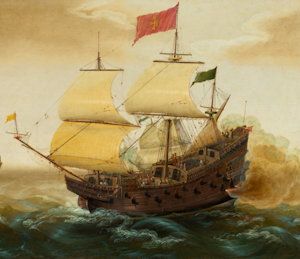 Galleon – This was a large three-masted sailing ship with a square rig and usually two or more decks. They were popular from the 15th to the 17th century and were especially built by Spain as merchant and military vessels. They were too cumbersome to be used by pirates. Traditional galleons were only made until about 1650, but the term continued to be used by the Spanish for all ships trading with the New World of 400 tons or more with 50-60 cannons. For a debunking of the myth that pirates ever used galleons watch the edifying video Did Pirates Ever Use Galleons? on the Gold and Gunpowder YouTube channel.
Galleon – This was a large three-masted sailing ship with a square rig and usually two or more decks. They were popular from the 15th to the 17th century and were especially built by Spain as merchant and military vessels. They were too cumbersome to be used by pirates. Traditional galleons were only made until about 1650, but the term continued to be used by the Spanish for all ships trading with the New World of 400 tons or more with 50-60 cannons. For a debunking of the myth that pirates ever used galleons watch the edifying video Did Pirates Ever Use Galleons? on the Gold and Gunpowder YouTube channel.
Galley – Real galleys were impractical for pirates as they needed large crews and had little space for supplies and booty. Although they might have been effective in the shallow waters around the Caribbean islands, they were too unstable to be of use on the high seas and in bad weather. Although not strictly speaking galleys, many ships in the Americas did have oars known as sweeps, which were 5 to 6 metres long. They needed 3 men, probably standing upright, to use. Special oar ports called scuttles were cut into the sides of the ship, either between the guns or on a deck of their own. When not in use they were stored either along the outside of the ship or racked amidships. A galeote or half galley was a small galley-like vessel, about 27 metres long and with two masts. They were faster and more versatile than a galley, being popular with the Spanish in Caribbean, widely being used for coastal protection and pirate hunting. For more information on pirates and galleys watch the interesting video Rowing for Plunder: Pirate Galleys (1630-1730) on the Gold and Gunpowder YouTube channel.
Flute – (Dutch – Fluyt) A Dutch ship with a low draft, which could hold a lot of cargo and only needed a small crew. They were quite slow and were therefore didn’t make ideal pirate ships.
Ketch – A two-masted vessel with a square-rigged main mast and lateen mizzen. It had a rounded stern and could be unwieldy, making it not the best of choices for a pirate vessel.
Pink – This was a small flute with a rounded bow and narrow high stern. The rigging could vary and they could be up to 140 tons. They were fast and could carry 20 guns, making them suitable as a pirate vessel.
Schooner – A fore-and-aft rigged sailing vessel having at least two masts with a foremast that is usually smaller than the other masts. They were square-rigged on the foremast and mainmast, and fore-and-aft rigged on the mizzenmast if present. The term was first used in the early 1700s and the vessels became popular in that century. They were fast, but difficult to sail. Although an iconic ship in pirate literature, there is no real evidence of them being used by pirates.
Sloop – Recorded as being the most popular pirate vessel, sloops were perfect for the Caribbean. Bermuda and Jamaica were both centres for the construction of these vessels, which although technically not a ship were often referred to as one. They were in fact single-masted, fore-and-aft-rigged sailing boats with a short, standing bowsprit if at all, and a single headsail set from the forestay. They normally had a flat stern and a rounded bow with a low freeboard. In the period they usually weighed between 5 and 40 tons, but later became heavier with more sails added. They carried from 2 to 20 light guns, depending on the size. This boat was much favoured by pirates because of its shallow draught and manoeuvrability. They often possessed oars, which made them even more versatile. In the Royal Navy the term sloop could signify any light support vessel carrying less than 20 guns. For more information on pirates and sloops check out the elucidative video Sloop: The Pirate’s Favorite Ship (1680-1741) on the Gold and Gunpowder YouTube channel.
Types of boats used by pirates
In addition to the larger vessels, pirates also made use of smaller ones which could be stowed on board or towed. They were used for boarding their victims’ ships, as well as transporting men and goods between there own vessels or to land. To learn more about pirates and smaller boats check out the entertaining video Why the Rowboat was the best Pirate Ship on the Gold and Gunpowder YouTube channel.
Canoes – Usually carrying 8 to 10 men, they were made from a hollowed out tree trunk, and were flat bottomed. They were useful to buccaneers as they were light and could be easily transported over land. Europeans usually rowed them in contrast to the natives of the Caribbean, who used paddles.
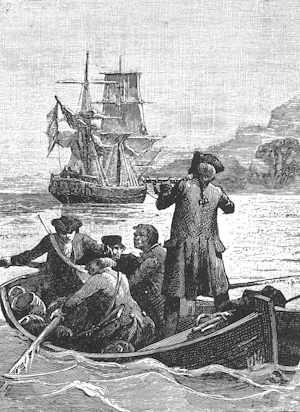
Jolly boat – A light boat carried at the stern of a larger sailing ship with four to six oars.
Long boat – This boat were also known as launch, pinnace, or yawl, and were similar to piraguas. It was a light boat propelled by sails or oars, used as a tender for merchant and war vessels and for communication between ship and shore. It was also used to move large loads such as anchors, chains, or ropes. The long boat was the largest boat carried by a ship, which was either towed or stored on board. They were sometimes fitted with swivel guns or small cannons.
Piragua – The Spanish name for this boat, the English calling it a periagua and the French a pirogue. They could carry between 30 and 100 men. It was basically a large canoe with one or two sails, and was typically used in the Caribbean by pirates to catch much larger vessels. The piragua was about 10 metres long with 12 to 14 oars. They were good for use on rivers and in shallow waters, but not very good on the open sea as they could easily capsize. They were used by buccaneers with great success in 1680 to overwhelm and capture three Spanish barques, relying heavily on their superior musketry.
Wherry – A small, swift row-boat usually used in inland waters or harbours for transferring passengers and cargo.
Yawl – This was small ship’s boat crewed by rowers with the size, number of oars and sailing rig varying over time. Later the term was used to define a two-masted, fore-and-aft-rigged sailing vessel similar to the ketch but having a smaller mizzenmast projecting out behind the rudder.
Famous pirates ships
Here is a brief description of a few of the more well-known pirate ships. To learn more about the ships used in the Golden Age of Piracy, I recommend reading The Pirate Ship 1660–1730 written by Angus Konstam.
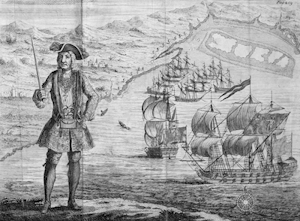 The Royal Fortune – This was the name of four or five of Bartholemew Robert’s ships. The first ship might not have been named the Royal Fortune and not much know about it. It is thought to have been a two-masted brig fitted with oars, carrying 16 guns. The second vessel was a fully rigged ship of 220 tons with 32 cannons. At first it was called the Good Fortune, but was later renamed Royal Fortune. It was eventually abandoned after becoming too leaky. The third ship was a 22 ton brig with 32 guns, and the fourth, which was probably the most famous, was a Dutch ship with a staggering 51 guns. This ship also became too leaky to sail. The fifth and final vessel was a frigate with three square rigged masts, which had been a slave ship belonging to the Royal Africa Company before it was taken by Roberts. It may have seemed less impressive than its forerunner, but was still a large ship of 410 tons with 12 guns later upgraded to 40. The forecastle was removed and quarterdeck lowered to improve sailing performance. Roberts died on this ship in a fateful confrontation with HMS Swallow, a fifth grade ship packing 50 guns. For more information on this ship check out the informative video on the Gold and Gun Powder YouTube channel titled The Royal Fortune.
The Royal Fortune – This was the name of four or five of Bartholemew Robert’s ships. The first ship might not have been named the Royal Fortune and not much know about it. It is thought to have been a two-masted brig fitted with oars, carrying 16 guns. The second vessel was a fully rigged ship of 220 tons with 32 cannons. At first it was called the Good Fortune, but was later renamed Royal Fortune. It was eventually abandoned after becoming too leaky. The third ship was a 22 ton brig with 32 guns, and the fourth, which was probably the most famous, was a Dutch ship with a staggering 51 guns. This ship also became too leaky to sail. The fifth and final vessel was a frigate with three square rigged masts, which had been a slave ship belonging to the Royal Africa Company before it was taken by Roberts. It may have seemed less impressive than its forerunner, but was still a large ship of 410 tons with 12 guns later upgraded to 40. The forecastle was removed and quarterdeck lowered to improve sailing performance. Roberts died on this ship in a fateful confrontation with HMS Swallow, a fifth grade ship packing 50 guns. For more information on this ship check out the informative video on the Gold and Gun Powder YouTube channel titled The Royal Fortune.
The Queen Anne’s Revenge – Although Blackbeard started out on his pirating career on a sloop, he was later to captain one of the most formidable pirate ships ever – The Queen Anne’s Revenge – which was originally a French privateer/slave ship called La Concorde, captured in September 1717. It was a three-mast, fully rigged ship of 250 tons and sleek build. Extra gun ports were cut into the side and although the forecastle was removed the quarterdeck was retained, probably serving as a gun platform. The ship eventually carried 40 guns making her one of the most fearsome warships in the Caribbean. She was the flagship of Blackbeard fleet and always sailed with number of consort sloops. The ship was named after Queen Anne, the last Stuart monarch, revealing Blackbeard’s Jacobite sympathies. She met her end when she ran aground on a sandbar and sank off the coast of North Carolina in May of 1718, shortly after the blockading of Charleston’s harbour.
Ranger – Charles Vane’s most prominent ship was a large slaving brigantine captured in summer of 1718. It became his flagship until he lost it to Jack Rackham who in turn lost it two months later. It was a fast two-mast vessel that carried a square-rigged foresail, topsails, and a fore-and-aft rigged spanker abaft her mainmast with a triangular main staysail between the two masts. Vane’s ship is thought to have carried 12 guns and a crew of as many as 80 men.
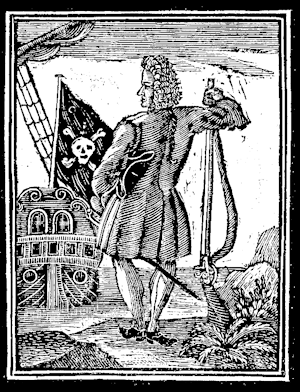 The Royal James – This single-masted Jamaica/Bermuda sloop was paid for by Stede Bonnet and originally named Revenge. It carried 70 men and 10 guns. It was eventually captured by pirate hunters searching for Charles Vane in September of 1718.
The Royal James – This single-masted Jamaica/Bermuda sloop was paid for by Stede Bonnet and originally named Revenge. It carried 70 men and 10 guns. It was eventually captured by pirate hunters searching for Charles Vane in September of 1718.
The Adventure Galley – This conventionally constructed three-masted ship fitted with oars for mobility when there was a lack of wind, and armed with 34 guns, was built specially as a privateering vessel by a consortium of anonymous backers to hunt down pirates in the Indian Ocean and was captained by the infamous Captain Kidd. Unsuccessful at finding pirates, Kidd and his crew became pirates themselves, attacking ships of various nationalities. It was a potentially effective ship, but was poorly built and was abandoned after it started to rot. Kidd met his end on the scaffold in on 23rd May 1701.
For those interested in learning more about pirates ships in general, I recommend watching the videos below on Pirate ship types and Frigates and men o’ war. Also check out the Bretheren of the Coast for more vessels not covered here.
